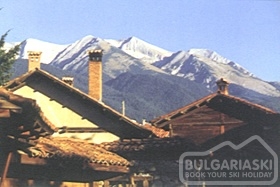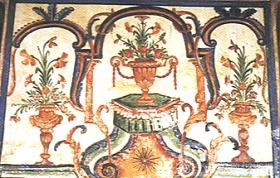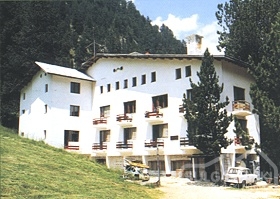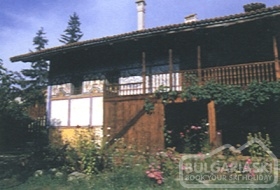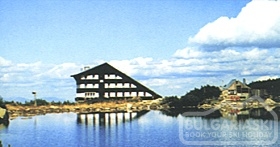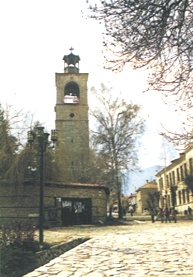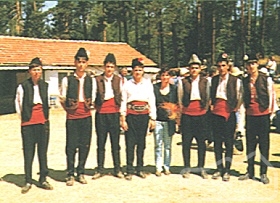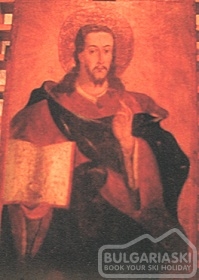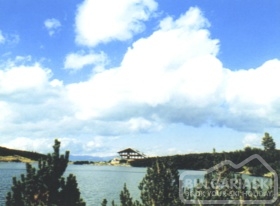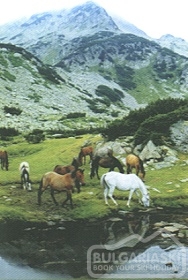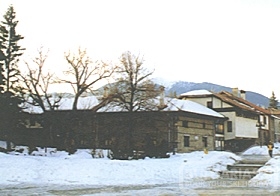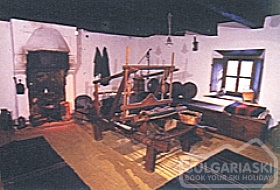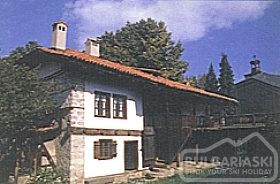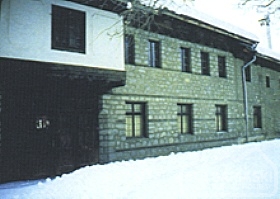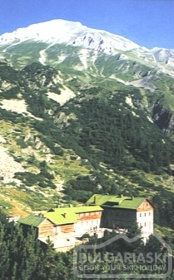History of Bansko
History of Bansko
The town of Bansko has both historical and tourist value. The town rose up on its present location around 9-10th centuries after the formation of the adjacent quarters of Bansko. In the middle of 18th century Bansko was a big and rich settlement developing crafts and trade. The caravans of Bansko traders travelled from the Aegean to Middle Europe transporting tobacco, cotton, precious goods, gold.
Bansko lived its "Golden Age" in the second half of 18th century and the beginning of 19th century when it reached economic and cultural peak: The art school of Bansko was established: the disciples of the school added many secular and historical subjects; a monastery school and a comprehensive school were opened. However, the Napoleon wars against Austria and the opening of the water way on the Danube put an end to its growth. In the middle of 19th century the economy of the town suffered decay. According to the resolutions of the Berlin Agreement Bansko was left within the boundaries of the Turkish Empire and its inhabitants actively participated in the consequent rebellions - Kresna-Razlog rebellion (1878-1879) and the Ilinden- Preobrazhenie rebellion (1903). The town was liberated from the Turkish rule on 5th October 1912 (the Balkan war). Bansko is the native place of the titans of the Bulgarian Revival period Paisii Hilendarski and Neofit Rilski. Interesting sights: First of all this is the Sveta Troitsa (St. Trinity) church (the biggest and the richest in the region of Pirin), its construction was completed in 1835; it strikes the viewer with beautiful frescoes and woodcarvings made by Master Ousta Velyan Ognev. The most outstanding representative of the Bansko art school - Dimitar Molerov, decorated the icons. The size of the temple is impressive; too big for that time. A 30 meter high stone tower rises up in the yard of the church (built by Master Grigor Doyuv in 1850) with a belfry and a clock made by Todor Hadjiradonov and installed in 1869. It is located in the centre of the town behind a tall stone fence.
The Virgin Mary church was built in 6th century and restored at the end of 8th century and the beginning of 19th century has wonderful woodcarvings of the iconostasis. The native house of Neofit Rilski - preserved in its initial outer appearance and well known as the Benin House. It is situated in the immediate neighbourhood of the St. Trinity church on 17, Pirin Str. (tel.: 07443 4005).
The Velyanova Kashta (the House of Velyanov) - a monument dating back from the Renaissance; one of the most beautiful houses having a rich fresco decoration and fine woodcarvings (2 Velyan Ognev Str., tel.: 07443 4181). The Sirleshtova Kashta (the House of Sirleshtov) is a small fortress. The special role of this house in Bansko is marked by the one-meter thick stone walls, the narrow and dark loop-holes, the iron wires on the windows and the heavy doors. The Todeva (Buinovata) Kashta (the House of Todev) is a masterpiece of construction and the subtle feeling for beauty in everyday life. It was built in 1835. The House of Culture and the Art Gallery of Bansko (tel.: 07443 2292, 5504, 5096). A monument of Father Paisii Hilendarski in the centre of the town at the place of his native house.
As for the transport, the basic type of transport that connects the town to the rest of the country is the bus transport. There are regular bus lines to Sofia, Blagoevgrad, Gotse Delchev, Razlog, Dobrinishte and many other villages in the district. The central bus station is modern and huge. It is located in the eastern end of the town on the main road Sofia-Blagoevgrad- Gotze Delchev, to the railway station. Bansko happens to be the last but one station on the narrow gauge line Septemvri- Velingrad-Dobrinishte. The railway station is behind the bus station (tel.: 07443 2215).
Surrounding areas: Most impressive is the legendary mountain of Pirin. The bigger part of the tourist flow heading for the mountain goes through the town. In the immediate vicinity are the ski centre called 'Chalin Valog', ski centre 'Shiligarnika' one of the biggest in Bulgaria, the chalets of Demyanitza, Bunderitza, Vihren as well as the top peak of Vihren. Bansko Karst springs in the area of Murtva Polyana (Dead Meadow); a ceramic workshop of late ancient times, a fortress called Stana Kale and a necropolis both of late ancient times; Thracian fortress and necropolis together with early Christian basilica in the area of St. Nicola; Thracian tomb in the area of Lisicha Mogila (Fox's Tomb); the Virgin Mary's Birth church. 6 km south of Bansko is the village of Dobrinishte (final station on the narrow gauge line from Septemvri). It is one of the largest villages in the country with a population of over 3000 inhabitants.Famous to be the Gate towards the magnificent Pirin Mountain, Bansko is the newest and fastest developing of the Bulgarian winter ski resort with a growing influence upon the summer season, hosting more than 1300 000 tourists annually, including a large number of foreigners. For the inhabitants of the capital, it its the favorites rest and entertainment site during the weekends.
The specific atmosphere of the Bulgarian National Revival, the rich cultural-historic heritage, the preserved folklore and crafts, the original cuisine, the plenty of cozy and snug small private hotels and taverns in traditional style, combined with the marvelous and picturesque nature of Pitrin and the thermal mineral springs in the adjacent Dobrinishte, makes Bansko an unique tourist center where the number of the summer visitors grows every year and for the first time in 2001 the number of summer and winter holidaymakers was equal. The town has its statute of an unique settlement ,acquired international significance for the economic tourism (since 1979), where 60-70-% of the inhabitants are employed. the rest 30-40% make make their living wit woodcarvingIn Bansko one can see 150 cultural monuments. Five of the monuments are of national importance :"St Trinity" Church with the clock-bell tower; "The Velyanova House" with an artistic decoration, made by Velyan Ognev-one of the remarkable representatives of the Bansko School of Fine Arts:The house- museum "Neofit Rilski"; the house museum "Nikola Vaptsarov" ;"Uspenie Bogorodichno" church. Bansko architecture is unique - brilliant example of "The Bansko fortified house" style among wich noteworthy are: "Velyan Ognev, "Neofit Rilski", "Getchkova Razkrastitsa", the architecture ensemble across "Pirin" St.,"Djidjevi Houses", "The Zlatevi Houses", "Kojuvi Houses", etc.
Bansko is the birthplace of plenty of outstanding Bulgarians among wich: Paisiy Hilendarski - name-luminary in our national culture and education, aouthor of th first Bulgarian History, called Slav Bulgarian History; Neofit Rilski - Patriarch of the new Bulgarian education and enlightement; Nikola Vaptsarov - word aknowedges poet anti fascist, the only one Bulgarian awarded with the International Peace Award; Toma Vishanov - Molera - founder of the Bansko School of Fine Arts
The Pirin national Park is the largest protected site in Bulgaria with total territory of 40 455,9 ha, 36% of which are within the boarders of Bansko Municipality. because of its unique natural resources, it is the included in the list of monuments compiled at UNESCO according to the Convention for preservation of the world cultural, historical and natural heritage. The territory within Bansko comprises the most beautiful and attractive part of the Pirin Mountain with its highest peak Vihren (2 914 m) - the second highest peak in Bulgaria and third on the Blakan peninsula; the imposing rock phenomena "Koncheto" (The foal) and "Stragite" (the guardians) - alpine climbing national sites, the natural site Banderista & Kazana - two of the deepest caves in Bulgaria. The cirque Bansko Suhodol is one of the not much left permanent snow-site in Bulgaria, where skiing can be practices till the late summer. Over 100 of the total 176 beautiful high-mountain alpine lakes have glacial origin, well known as the "Crystal eyes of Pirin", the fantastic waterfalls Banderishki Skok, Yulenski Akok and Demyanski Skok are also beautiful natural site. The famous Bykusheva Mura (Baykusheva white fir ) is the oldest tree in Bulgaria at the Age of 1300 years and is at the same age as Bulgarian State. The newest reserve in Bulgaria is Yulen, covered with age-old white fir forest. Here are represented almost all of the flora and fauna species, a significant part of which are local Pirin, Bulgarian ende-mytes and relicts, including the symbol of Pirin - the snow-white edelweiss. During the hot months Pirin attracts thousands of bulgarian and foreigner holidaynakers, fond of nature and adventures, while the access to the tourist paths. Along the ridge to Peloponnesian Peninsula. In winter Pirin offers excellent conditions for skiing in the ski sites - Shiligarnika, Bandershishka meadow, Chlinollow above Bansko , as well as Bezbog - above Dobrinishte. In the highest parts of the park are builtt several tourist shelters Tevno Lake, the chalets Vihren, Banderitza Damyanitza and Bezbog as well as the mountain hostel Academica; and in the lower part above Bansko - the tourist complex Shiligarnika with several holiday centers nearby. Just on the borders of the Pirin National Park are situated the chalet "Gotse Delchev" and the tourist base "Mocharata". A major starting point for the chalets Bandersita, Vihren and Demyanitsa is the town of Bansko, and for Gotse Delchev and Bezbog - the village of Dobrinishte. Among the most beautiful and impressive sites of Pirin is: - the highest peak Vihren (2914 in). North Firm is on the main ridge between the peaks Kntelo I and Hvoynati: a major starting point - Bansko. 17 km of asphalt road southweslwards to the chalet Vihren (3h-3h30 on foot) or 4h30 along a marked tourist path (see tourist itinerar- ies) and 2h311 walking tour west - northwest climbing the peak from Kresna Municipality (and 2 hours back to the chalet).
The, most attractive and visited lakes, being a fantastic tourist attraction are: Hvoynato Lake (Ovinatii, Murutovo) North Pirin: in the small and shallow Hvoynati cirque, put into the large Baitderishki cirque, between Hvovnati and Granite peaks and part of the Donehovi Carauli ridge southwest from Bansko. From starting point chalet Vihren - 1 hour along marked tourist path southwestwards to the Banderishka gate (see tourist itineraries) Ribno (Fish) Golyamo (Grand) Banderishko Lake North Pirin: in tlie huge Bunderishki cirque - one of the biggest and prettiest in Pirin Mountain, formed by the main ridge between Vihren, Hvoynati und Granite peaks, Donchovi Carauli ridge, Banderis'hki rockv peak and pan of the Todorino ridge southwest from Bansko; from starting point chalet Vihren - 45 minutes southwards along marked tourist path passing by the Okoto Lake (Eye Lake) towards the chalet Demyanitsa with slight right detour. Dalgo (Long) (Gorno (Upper) Valyavishko Lake. North Pirin; in the upper part of the Banderishki cirque soutwest of Bansko: with starting point chalet Vihren - 1h40 southeastward along marked tourist path to chalet Demyanitsa and across the Gluvnishku Gale towards the shelter Tevno Lake and the chalet "Yane Sandanski". Golyamo (Grand), Gorno (Upper), Dalgo (Long) Valyavishko Lake. North Pirin; Valyavishki cirque - one of the prettiest in Pirin: formed by the Valyavishki rocky peak, Momin Dvor, Samodivski and Malak Polean peaks south from Bansko: with starting point chcilel Demvanilsa - 2 hours south-southwestwards along marked tourist path towards the chalet Bezbog . With starting point chalet Bezhog - 3 hours southwest along marked tourist path towards chalet Demyanitsa across the Samodivska Gate. Two high mountain lakes - Gorno (Upper) and Doino (Lower). The Upper Polejan Lake is the highest lake in Bulgaria, situated at 2 710 m above the sea level with total area of 2,2 dk. and almost oval form - its length is approximately dl) 111 and its width is approximately 50m. The Lower Polejan Lake situated at 2 462 m above the sea level is larger - 11,8 dk., 160 m long and 100 in wide. Popovo Lake (Papazgyol). North Pirin, Popovski cirque southeast of Bansko: with starting point chalet Re:liog - lhl5 southwestwards along marked tourist path to chalet Pirin near the Banski Lakes; with starting point chalet Demyanitsa - 3h55 southeastwards along marked tourist path to chalet Bezhog with It) minutes south detour near the Banski Lakes towards the chalet Pirin (see tourist itineraries). It is the biggest in Pirin - 123,6 dk. and the second biggest on the Balkan Peninsula after the Smradlivo (the Stinking) Lake in Rila (212 dk.). It is also the deepest in Pirin - 29,50 m and the second deepest in Bulgaria after the Rilsko Oko (Rila Eye) Lake-37,5m
Archeological complex Pirin, the site St. Nikola; 4,5 km southest from Bansko, including 2,5 km asphalt road and 1,5 km dirt road; eith starting point Bansko - 1h. 30 min walking tour; with staring point Dobrinishte - 1 hour walking tour.
Ancient fortress Pirin, within the territory of Yulen Natural Reserve. Late ancient fortress Stana (Sitan) Stronghold. Pirin the site Kalyata. Late ancient and mediveal fortress Momina Tower (Maiden Tower). Pirin's part of the Mesta river valley; on the land of village of Kremen. Nowadays in the old quarter of Bansko one can see brilliant examples from different stages of development of the Bansko fortified House from the mind mind 17th century till 60s of the 19th century. Bansko School of Fine Arts. Toma Vishanov -Molera is the founder of the school. It was formed as a woodcarving and artistic school at the end of XV||| and the beginning of the X|X century and is one of the most remarkable phenomena in the Bulgarian cultural history.
Architecture-ethnographical museum, which decoration is announced to be a cultural monument of national importance. On 5 October 2002 it is 90 years ago that the liberation from the Ottoman Yoke in 1912. On this occasion the town celebrates an anniversary holiday with rich authentic folklore program - Men's folklore fine Arts in Koprivshtitsa, performed concerts in the former yugoslav Republic, Germany Spain; authentic folklore songs, humorous Bansko folk, performance of traditional folklore customs;
Local cuisine: Bansko kapamma, chomlek, Katino mezze, Banski starets (Bansko old man) or babichki (little old women) -dry appetizer, Kreshchina(Bansko leg pork) - dry appetyzer, Barkada Banski kachamak (Bansko hominy). Community Centre "Nikola Vaptsarov" - town of Bansko. It is established in 1884 in "The Sarandovo Cafe" bearing the name "Rural Rest". The Community Center existed till 1903, in order to revive again on II October 1908 with the name "Development".
Activities: Library work; Library stock of 60 000 volumes of literature, divided among the following departments: children's department with a reading room, adults ' loaning and reading rooms. Annually the library is visited 14 870 times, and the registered readers are 1580. The loaned literature accounts 25 000 volumes.
Arts and creation activity: Men's Folklore Ensemble - Laureates and winners in the fairs "Pirin Sings", "Koprivshtitsa", "Rozhen", "Balkan Folk", etc; participations in concerts around the country and abroad (Former Yugoslav Republic of Macedonia, Federal Repub lic of Yugoslavia, Hellenic Republic, Spain, Germany, etc). Women's Folklore Ensemble - gold medals from "Pirin Sings". " Koprivshtitsa ", "Rodzen ", participations in the 11 International Festival "European Music Night" in Ljubliana, Republic of Slovenia, successful tours in Macedonia, Serbia, Greece, Spain, etc. Mixed Folklore Ensemble - gold medals from festivals and fairs, participations in concerts around the country and abroad. Junior Folklore Ensemble - silver medals from "Pirin Sings 1999", and for the students of folklore -the opening of "Koprivshtitsa 2000 " Fair; participations in concert shows around the country and abroad. Folklore Dancing Ensemble - gold plate from the Children's International Folklore festival in the State Kuwait, carried out in May 2000, gold medals in "Pirin Sings", concert show visits in Macedonia, Serbia, Greece. Old-town Songs Company "Edelweiss" - laureates of the Festival "Golden Chestnut" - Petrich, solo concerts in Macedonia. Children's Vocal Company "Zvezditsa"- 3rd place in the "Golden Cock - 2000 " Festival - Blagoevgrad, 2nd place in the "Rila Bells - 2000" Festival - Sapareva Banya; 2nd place in the I International Popular Song Festival - 2001 - Petrich. There are plenty of individual awards from the above-mentioned festivals.
Children's School of Fine Arts: piano and accordion classes; piano class, accordion and wind, lute and folk singing class. Cultural events: Christmas and New Year's celebrations (concerts, children's mornings, New Year kukeri competition - Joint Kukeri Company takes part in the International Fancy-dress Games Festival in Pernik, celebrations of the Bansko tradition (evenings of the Banska lyric song, vivacious dances - horos, customs and rituals, culinary exhibitions, national costumes (nosiya) reviews, flowers holiday, etc).
The Community Center "Nikola Vaptsarov "hosts meetings, seminars, conferences, and symposia with local and national significance - Balkan Studies Seminar, "Bansko Tour" Presentation, International Arm-wrestling Tournament, International Jazz Festival, etc. Equipment - theatre hall with 450 seats, celebration hall, conference .hall, rehearsal hall, classrooms, foyers, suitable for exhibition performances.
Museum complex - Bansko has one of the best museum networks in the country. It comprises the following sites: House-museum "Neofit Rilski" - opened for tourists since 1981. The furniture and part of the premises including these of the monastery school (the so-called cell school) are restored. In the reconstructed farm buildings a documentary hall is established, representing the public activity of Neofit Rilski.
The Velyanova House has some unique architectural and artistic characteristics and depicts the typical interior of the Bansko home during the Bulgarian National Revival. The frescos and the fretwork are made by the artist-wood-carver - Velyan Ognev. It is opened in 1977. House-museum "Nikola Vaptsarov". Opened in 1952. It includes restoration of the living premises where the Vaptsarovs lived. The family background, where the famous Bulgarian poet grew up, is pre- sented in the large exhibition hall at the ground floor. The life of Nikola Vaptsarov after his enrollment in Marine and Machine-engineering School of Varna, is followed in another exhibition on the second floor. Rich photo and documentary material, relevant to the life and the creative work of the poet as well as his international recognition is presented too.
Arts center A permanent exhibition- bazaar of the traditional ethnographic textile from Bansko and its region, icon copies, arts souve- nirs and fretwork by the representatives of the arts and crafts guild "Made in Pirin" is presented. In the exhibition halls different temporary presentations of famous Bulgarian and foreign artists are exhibited.
Permanent exhibition of the Bansko Icon-Painting School. One of the clearest expressions of the I Bulgarian XVIII and XIX centuries' culture. It is established in the building of the old Hilendarian nunnery. There are represented original icons by the founder of the school - Toma Vishanov-Molera, by his son - Dimitar, by his grandson - Simeon, by his grand-grand- son Georgi Molerovi and by other icon-painters as well. It is opened in 1986.
In the town of Bansko, in the old quarter, five minutes away from the center (Democracy Square), exists an architectural monument of national importance, comprising "St. Trinity " Church, The Clock Tower Belfry and the wall of the cult ensemble: The "St. Trinity" Church is Large Pseudo-Basilica with nave and two aisles - the second largest in Bulgaria after the Alex- ander Nevski Cathedral in Sofia (1912), built during 1832-1835 by the local master-builders, among which noteworthy is the name of Lazar Glushkov. Its paintings are connected with the outstanding Bansko School of Fine Arts masters - master Velyan Ognev from Debarsko (the unique wood carved iconostasis, the original frescos on the columns, walls and dome), Dimitar Molerov (the cruci- fixion and the throne - 1832, the big iconostasis icons - 1839-1841, the kissing icons) and Simeon Molerov (iconostasis icons - 1841).The bell tower in the precincts of the church, built in 1850 by master Gligor Doyuv is 30 m tall; in 1866 a clock, made by the self-taught master Todor Hadjiradonov from Bansko was installed. This specific characteristic makes it one of the most outstanding artistic achievements of the Bansko culture from the Revival period. Today the church is active, functioning and is part of the museum complex in the town.
"Uspenie Bogorodichno" Church Architectural-construction monument of national importance, semi-dug, stone single-abside construction with a three rows perch, double sloped roof and double gate, built during XIII-XIV century, enlarged in 1808. The interior is divided into 2 parts of a massive wall with three openings. It is famous with its unique iconostasis, the so-called Banski iconostasis - one of the most precious masterpieces of the
Bulgarian wood-carving art - the basic elements are the flowers among which images of birds and fairy tales animals are involved (in the beginning of XIX century part of the iconostasis is dismantled and took out abroad, and on the someplace was put another - an older one, probably belonged to the same church before its reconstruction). The bishop 's throne attracts a great interest. The icons were made by the founder of Bansko School of Fine Arts Toma Vishanov - Molera but are demolished by a great fire in 1958 and were changed with copies of the originals. Today it functions as a tomb-church.
-
jonathan ellul From malta
Sent on 09 July 2012my friend and i went to bulgaria last april and we stayed there for two weeks. We stayed at family hotel bisser 16 el tepe street 2770 bansko. We would like to thank the staff and especially mamma and her daughter velina too for their help and excellent service i would recommand that hotel coz its cozy,clean,staff really cheerful and helpful and breakfast was wonderful. During the day we go eat at momini dvori restaurant. Food there was wonderful and service thanks to our waiter dimitri and his crew we enjoyed being there everyday and welcomed like kings. The rest bulgaria is a wonderful place which i recommend for a relaxing holiday. -
Erik Rooze From Netherlands/Greece
Sent on 28 January 2012We have spend this winter (2011/2012) holidays in Bansko and where really delighted. It is so nice and friendly and clean. Normally we go to the Alpes, but for our young daughter (7 years) this is really nice. Because I'm 60 years and the wife 35 years we do not care that there is not much of after ski. The resort is really cheap, which I like as a Dutch man. I could not spend all my hard earned monies in Bansko. As we live in Greece now, on the island of Aegina near Athens, it it a nice drive by car. I can reccomment this area to you all! -
Erik Rooze From Netherlands/Greece
Sent on 28 January 2012We have spend this winter (2011/2012)hollidays in Bansko and where really delighted. Is is so nice and friendly and clean. Normally we go to the Alpes, but for our young doughter (7years) this is really nice. Because I'm 60 years and the wife 35 years we do not care that there is not much of after ski. The resort is really cheap, which I like as a Dutch man. I could not spend all my hard earned monies in Bansko. As we live in Greece now, on the island of Aegina near Athens, it it a nice drive by car. I can recomment this area to you all! -
carl jones From wales
Sent on 16 March 2011Just got back from a weeks skiing in Bansko the weather was hot but we had a dump of snow on the Monday grate skiing i wasn't sure about going there but glad I did, I have skied for 8 years some of the slopes were testing its not a vast area you could ski the lot in 2 days but the scenery made up that beautiful, I stayed in the Lion Hotel I would recommend staying there the rooms were big and the food was very good very friendly people. there was a mini bus from the hotel to the lifts and back every day no walking, the hotel is a 5 minute walk to the lifts if you wanted to walk, if you wanted to eat out i would go down to the old town very cheap 55p a pint and 35p for a glass of wine or Ј1.50 for a bottle of wine there was 4 of us we had 4 big meals wine and beer for 3 hours it cost us Ј34.00 total if you want to party stay top end prices Ј1.60 a pint up there I had no problem with the lifts passes i read that they stopped working after a few days the passes were fine I will be going back next year holiday 8 out of 10 only 1 thing you need to get to the lifts early or you will have a wait for 30 minuets other than that grate holiday PS Got 2 sets of skis fully serviced for Ј37.00 nice and cheap don't worry about going there you will have a good hoilday. -
kezdevil From UK
Sent on 16 March 2011Went to Bansko 7-14 March 2011 - had a fantastic time. Snowed on first day so had powder to play on though by the end of the week conditions were not quite as good. Had to work hard to avoid goggle tan as it was so sunny! We had read worrying comments about gondola queues but really didn't see any when we were there. Weekend was a bit busier on the lifts than the weeks but nothing major. We got up and out early. The gondola starts at 8.30am and we were on it by 8.40 most days. We stayed at Eagles Nest Apartments and would stay there again. Good facilities, well equipped kitchen (we did self cater a couple of nights). -
Jacob From Israel
Sent on 10 March 2011Don't go to the "Pirin" hotel, Bansko ski resort, Bulgaria My family and I stayed at the "Pirin" hotel in Bansko, Bulgaria from the 28th of February till the 6th of March. We enjoyed the mountain resort and had great time skiing and snowboarding. One of our rooms had only one bathrobe, but we didn't pay much attention to this, and used only one bathrobe when we went to the pool. As we were leaving the hotel, the receptionist told us that we are missing a bathrobe. We told her that we didn't have two bathrobes to begin with, and we absolutely don't need to take a bathrobe with us home. At this moment she told us that she wouldn't give my sisters' passport back unless we pay 70 lv( which is approximately 35 euros) We tried to explain that we didn't hide or burn or do anything with the bathrobe, and we didn't even use it because we didn't have it in our room. "You should have reported it as soon as you got the room", well, it's not my job to count various objects in the room, and report my findings to the receptionist, I told her. "It is impossible to have only one bathrobe" was the only answer I got, and after threatening us by calling the police, and showing off their security thugs, I had no choice but to pay for the bathrobe I never even used. It was a very embarrassing experience, and a very bad way to end a great vacation, needless to say 35 euros were stolen from me with nothing I could do about it. But the most amazing part was that I spoke to another couple, on the way to the airport, who stayed in this hotel, and they said that the hotel staff did the exact thing to them! I really enjoyed Bansko, the atmosphere there is amazing, the ski slopes are great and the people are very friendly, but if you ever go there DO NOT stay and the Pirin hotel! They lied and stole my money. -
Tibi From Romania
Sent on 08 February 2011Hey there guys, Just got back from Bansko ski resort.We were there for 7 nights and here are some facts: --the waiting line at the Gondola is at least 30 minutes...we stood there 1 hour and a half... --very big and boring waiting time to get your ski-pass.... --the apres-ski almost doesn`t have music at all and there`s no fun happening there.... --the slopes were pretty bad at 12 o`clock even though they had been prepared....(it did not snow at all one week, only snowguns) --too many injured people....a lot of idiots on the slopes --people there speak english just a little... --I RECOMMEND Friendly PUB!!!!! Great place --don`t go to Panorama hotel....they don`t speak english and it really ain`t a 4 star hotel.... Not what i expected from this ski resort...last year i was in Borovets and had lots of fun there!!!!!
Please, post a comment on Bansko mountain resort in Bulgaria.
We will greatly appreciate this. It will help us improve the content of this website, so other people know what they can expect.
- Book a ski holiday in Bulgaria
- Family ski holidays in Bulgaria
- All Inclusive ski holidays in Bulgaria
- Ski holidays for beginners in Bulgaria
- Group ski holidays in Bulgaria
- Luxury ski holidays in Bulgaria
- School ski holidays in Bulgaria
- Ski holidays in Bansko
- Ski holidays in Pamporovo
- Ski holidays in Borovets
- Ski holidays in Chepelare

 En
En
 Ru
Ru
 Gr
Gr
 Ro
Ro


